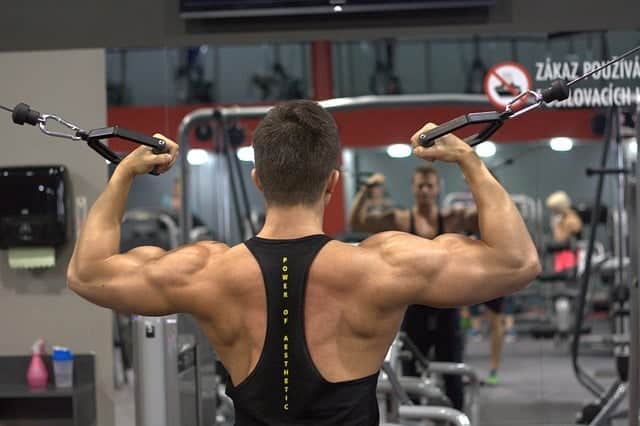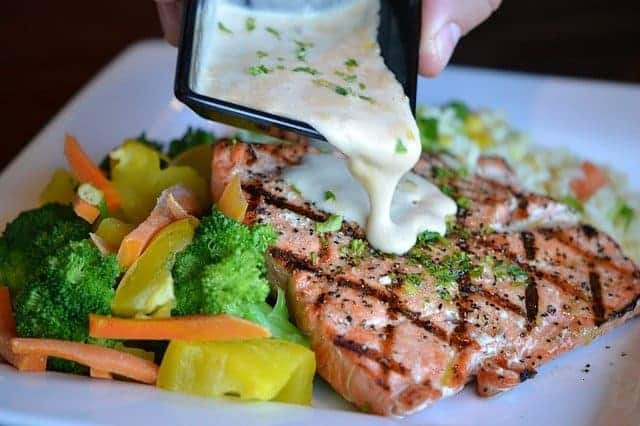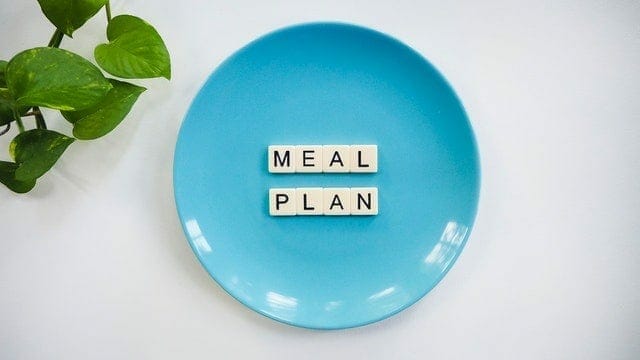What to eat after training, what to eat before training – these questions bother most people striving to shape the ideal body shape. Everyone knows that post-workout meals play a very important role in the process of shaping muscles and burning fat, but few people know exactly how to compose them. Post-workout meals have an impact on, among other things, our physical performance and the level of strength during exercise, on muscle work, the rate of mass gain or the body regeneration process. Many people who train consider the pre-workout meal and the post-workout meal to be the most important meals of the day.
Are you training and would like to optimise your diet to see positive changes in your silhouette as soon as possible? Read the article and find out what to eat after training to replenish your muscles with fuel, improve the work of the whole body, recharge your batteries before the next exercise session and protect yourself from possible increase of unwanted fat tissue!
Table of contents
Post-workout meal – an important part of the body building programme

Followers of training can be divided into those who pay little or no attention to their diet, believing that everything will be taken care of by nutrients and supplements, and those who are aware of how important nutrition is for achieving specific silhouette effects. The latter are of course right. What we eat is crucial to our fitness, mental and physical form, as well as to the rate of muscle growth and fat reduction. Dietary supplements are of course important accelerators of the whole process, but they are not the most important. Nobody has built muscles or lost weight on supplements alone.
In order for our muscles to gain volume and proper shape, they need to be fed on a regular basis. In order for the fat tissue to disappear systematically, it must be stimulated to disappear, among other things through food that speeds up metabolism. Without regular, well-balanced meals our metabolism will slow down, and muscle tissue will atrophy instead of growing.
The post-workout meal is particularly important in our menu, because it determines whether our muscles receive the appropriate dose of energy and building material needed for growth. If they don’t, they will start to “devour” themselves.
What does the post-workout meal give us?
- It improves the body’s regeneration process after exercise.
- Replenishes the loss of water and electrolytes that occurred in our body during exercise (mainly as a result of increased sweating).
- Provides a boost of energy after strenuous exercise, reduces the effect of exhaustion and lack of desire to act. Improves general wellbeing and helps us stay active until the end of the day.
- It participates in the reconstruction of glycogen, which is an energy reserve for the body. Glycogen deficiency occurs after intensive physical effort. A post-workout meal helps to store it again.
- It has a positive effect on our overall physical performance, preventing deterioration during intensive and demanding workout plans. After intensive exercise it helps you quickly return to your peak exercise capacity.
- By improving muscle function, it accelerates the effects of exercise.
- Prevents hunger attacks some time after exercise (e.g. at night).
- It is fuel for muscles working at high intensity. Not only does it prevent muscle breakdown due to exercise and depletion of energy resources, but it also stimulates muscle protein synthesis, contributing to faster muscle growth.
It should be noted that post-workout meals will look slightly different for every active person. Although the general principles of their preparation remain the same, the specific composition of meals and the amount of food will depend on several factors such as: the goal of training (e.g. mass, reduction or general improvement of body shape), metabolic rate, age, weight and body build, time of exercise.
What to eat after training for mass?

If you’re training for mass, a properly composed post-workout meal is extremely important for the success of your training plan. It determines whether our muscles will receive building materials for growth, or whether due to the lack of fuel, exhausted by hard effort during exercise, they will start to take energy from their own resources, in other words, instead of growing, they will start to shrink.
Post-workout meal for mass should consist of two parts. The first, small meal, consisting mainly of carbohydrates, is eaten immediately after exercise (up to 20 minutes after), and the second, large meal with high nutritional value and significant calories, is eaten up to 2 hours after exercise.
When it comes to a small meal right after the workout it can be a simple, quick snack such as: protein bar, banana, smoothie. It is only meant to temporarily “feed” exhausted muscles and initially replenish glycogen stores in the muscles, so it doesn’t have to be a fancy dish. You can consume it at the end or immediately after exercise, or during your return home if you attend a gym.
On the other hand, a large meal after training should be highly substantial. Adepts of mass training are recommended to consume a large portion of easily assimilable simple carbohydrates during the post-workout meal, for example in the form of white rice – this allows you to richly nourish your muscles, avoid catabolism and compensate for the loss of glycogen in your muscles and liver.
After a hard, strenuous training for mass, it is also very important to replenish fluids in order to prevent dehydration. You can use mineral water or isotonic drink for this purpose.
What to eat immediately after strength training – quick fuel replenishment
Every strength training is associated with high energy consumption by muscles. If you don’t replenish this energy in time after strenuous exercise, you will fall into a state of short-term malnutrition, the consequence of which will be catabolism (breakdown of larger, complex molecules into smaller, simpler ones). Catabolic processes occur to balance the energy balance in the body and result in the breakdown of muscle tissue.
Failure to replenish energy stores after training can hinder our efforts to build ideal muscles. That’s why after completing strength training, preferably immediately or a few minutes after, maximally 25-30 minutes after, you should take a portion of quickly assimilated carbohydrates, i.e. those with a high glycaemic index. Sugars with a high glycemic index are rapidly released into the bloodstream and replenish lost energy, so they are very suitable for a small meal immediately after strength training.
The meal immediately after exercise can also include a small portion of protein rich in valuable amino acids and electrolytes for muscles. An interesting patent for such a post-workout energy boost are homemade shakes, for example from blended fruit and buttermilk or rice and yoghurt. We can also use ready-made nutrients and snacks for training.
Examples of snacks immediately after training
- 2 bananas
- Rice wafers and isotonic drink
- biscuits and 0.5 l milk
- 0.5 l strawberry buttermilk, large banana
- Cocktail with yoghurt, bran and raspberries
- Cocktail with yoghurt, cooked white rice and blueberries
- smoothie with avocado, spinach and apple
- bag of white rice, apple
- grape juice, banana
- cottage cheese mixed with kiwi and peach cut into small pieces
- fruit salad with mandarins, kiwis, cherries, pears and melon
- protein bar
- Milk and cocoa shake with added protein
- cottage cheese with raisins, banana and nuts
- whole wheat roll with peanut butter and jam
- Cocktail with kefir, oatmeal, grapes, nectarines,
- cocktail of yoghurt and dried apricots
- piece of watermelon, drinking yoghurt
Check: Ranking of Testosterone Boosters
What to eat after strength training – big, valuable meal

A small snack immediately after exercise will allow us to survive until the main meal, which should be eaten about 1 or 2 hours after the end of training. Ideally it should be a decent, substantial dinner, but not necessarily. It depends on what time our workouts take place. If you exercise in the morning you can have a hearty and varied second breakfast as a post-workout meal, if you exercise in the evening you can reach for a rich dinner. The main thing is the right choice and proportions of products included in our dish.
A meal following a strength training programme aimed at muscle tissue growth should be based on protein, preferably complete protein, which means that it contains all essential amino acids in appropriate quantities. Complete protein can be found in meat, fish, eggs and dairy products. The next important element of a post-workout meal are carbohydrates. For people engaged in intensive strength training in order to build and accentuate muscle, a good choice will be simple and starchy carbohydrates: white rice, white pasta, white bread, pancakes from white flour, potatoes. We should avoid products with a significant content of fat.
After training carbohydrates act as an express injection of fuel for muscles and the whole body. The higher the glycemic index, the faster they enter the blood and replenish energy stores. However, we don’t have to focus only on simple carbohydrates in our post-workout meal. We can combine them with complex carbohydrates (present in vegetables, wholemeal bread, cereals, legumes, thick cereals, wholemeal pasta, brown rice).
Such a duo will be even more beneficial: simple carbohydrates will help you feed your muscles and reduce fatigue in no time, while complex carbohydrates will ensure a high level of energy for a long time and no fluctuations in blood glucose levels.
However, protein remains the most important, as it is particularly important in the process of mass gain and regeneration. By consuming around 20-40g of protein as part of a post-workout meal, our muscles will have something to draw on for growth, and they will also rebuild more efficiently.
What to eat after strength training – examples of dishes
Here are examples of proven, nutritious and productive for muscle modeling post-workout meals. They are so universal that we can use them regardless of whether we train in the morning, at noon or in the evening.
- Scrambled eggs with tomatoes and chicken ham served with a graham roll
- Pancakes made from wholemeal flour, served with a filling of cottage cheese, nuts and raisins, topped with yoghurt
- Baked white pasta with tuna, vegetables and mozzarella cheese
- Hot poultry sausages, cottage cheese, wholemeal bread, tomato
- Soft boiled eggs, cottage cheese and smoked mackerel paste, wholemeal bread, cucumber, tomato
- Soup with cream of green peas, second course omelette with bran and ham
- White rice, bouquet of boiled vegetables, chicken breast rolls with mushrooms
- Tortillas with chicken, feta cheese, lettuce, tomato, cucumber and yoghurt-herb sauce
- Barley groats, turkey, mushroom and paprika stew, beetroot salad
- Roast yams, roast cod, Greek salad
- Parabolic rice, chicken meatballs in tomato and pepper sauce, cooked broccoli
Read also: Meals for mass
What to eat after workout on reduction?

While people aiming to build muscle don’t have to watch every calorie they consume (a calorie surplus is even advisable in their case), those on a reduction should pay attention to how much and what they eat, with particular emphasis on watching the supply of carbohydrates and fats. On the other hand, a big post-workout meal is necessary to replenish lost energy, eliminate fatigue, nourish the body and start the post-workout regeneration process. What to eat after training to lose weight? How not to waste the litres of sweat poured out during exercise?
Many people on a reduction cycle give up or severely deplete their post-workout meal for fear of weight gain. However, we do not have to worry about it. Muscles stimulated to work intensively use up a lot of energy not only when they are active but also for hours after the exercise. The burning of calories is therefore intensified after training, and practically everything we eat during that time will be used as fuel for the tissues, and not stored in fat reserves.
Consuming a satiating, rich meal after a reduction training doesn’t pose any risk of weight gain. Of course provided that you use healthy, dietetic food, and not calorie bombs such as fast food, sweets, pasta from white flour served with heavy, flour sauces, fatty meats with fries, etc. In this case, how to arrange meals after training in order not to gain weight?
Meals after training should be based on complex carbohydrates (thick cereals, natural rice, wholemeal pasta, legumes, wholemeal bread, cereals, grains, vegetables) and protein (lean meat, fish, seafood, eggs, leaner cheese). We rather avoid simple carbohydrates. For people on a reduction, carbohydrates with a low glycemic index are a better option. Of course sometimes we can allow ourselves a small carbohydrate snack with a higher glycemic index, but then we should adjust other meals of the day so as to stay in caloric deficit, which is necessary to lose weight.
In post-workout meals for reduction important place should also be taken by products with properties accelerating metabolism. They will help us keep burning calories at a higher level and improve the process of getting rid of unnecessary fat tissue. These are mainly spices such as chili pepper, black pepper, curry, turmeric, cardamom, Roman cumin, cinnamon, ginger, but also many other products such as marine algae(chlorella and spirulina), fish, lean dairy products, etc.
Read also: Diet to speed up metabolism
When preparing post-workout meals, we choose cooking, stewing, grilling, baking and frying without fat or with minimum fat as the method of heat treatment of products. Avoid frying with a lot of fat. Eat your meal about one hour after your workout and no later than two hours after.
Fit post-workout meal – recipes

In post-workout meals we use a large variety of vegetables. We combine them with groats, brown rice and other whole grain products, as well as fish and lean meat parts. If we prefer a vegetarian cuisine, we need to look for good sources of plant protein and create dishes from them, which will replace our meat. Great here are lentils, beans, chickpeas and other legumes, which are very rich in protein and from which you can create a variety of chops, meatballs, burgers, meatloaf, pâté, stews.
And here are some ideas for post-workout meals on reduction:
Dinner after training
Mini chicken breast steaks with zucchini, mushrooms, tomato and peppers
Prepare: half a chicken breast, 1 zucchini, 2 tomatoes and 1 pepper.
Cut the meat into slices. Slice the courgette and cut the pepper into strips. Parboil the tomatoes, peel them and cut into cubes. Sprinkle the chicken with oil and rub it with spices (chili pepper, sweet paprika, turmeric, oregano, thyme and garlic). Then fry the meat on a spoon of oil. Remove the chicken from the frying pan for a moment, put the courgette and pepper and fry them. Sprinkle with basil and oregano. After 3 minutes add the meat and tomatoes, which were removed from the pan earlier. Stew the dish for 20 minutes, stirring from time to time. Season to taste. Serve with pearl barley and lettuce.
Fish balls in dill sauce
Prepare: 0.5 kg fillets of pollock, hake or cod, 1 graham soaked in milk, 2 heaped spoons of wholemeal flour, 1 small egg, 3 heaped spoons of chopped dill, 2 heaped spoons of chopped parsley, salt, pepper, 150 ml of Greek yoghurt, 150 ml of vegetable broth.
Grind the fish with a blender. Add the graham, flour, parsley and 1 tablespoon of dill. Break in the egg, add salt and pepper. Knead into a compact, smooth mass. Form meatballs, which you put in boiling water. Cook over low heat for a few minutes. Pour 150 ml of vegetable stock into a saucepan. Add yoghurt, 2 large spoons of dill, salt and pepper to taste. Stir. Cook over low heat for a few minutes until the water has partially evaporated and the consistency is thick. Throw the meatballs into the sauce. Serve the dish with wholemeal pasta and cooked Brussels sprouts or green beans.
Read also: Diet for reduction
Dinner after workout
Egg muffins with feta cheese, broccoli and corn
We prepare: 5 eggs, half a cube of feta cheese, half a broccoli cooked and shredded into small pieces, half a can of corn, salt, sweet paprika and chili pepper
Crack the eggs into a large bowl and scramble them with a fork. Add salt, chili pepper, broccoli, corn, crumbled or finely diced feta cheese. Mix gently. Pour the mixture into a silicone muffin tin (to ¾ of the height of each cavity). Preheat the oven to 180 degrees. Bake muffins for about 12 minutes. Serve with light vegetable salad (e.g. from tomato, pickled cucumber and pepper).
Cottage cheese pancakes from the oven
We prepare: 250 g of semi-fat cottage cheese, 1 egg, 3 tablespoons of wholemeal flour, 1 teaspoon of sugar, a pinch of salt, half a teaspoon of baking powder.
Cottage cheese crumbled with a fork. Add the egg, flour, salt, sugar and baking powder. Mix. Knead into a compact, smooth mass of such consistency that you can easily form pancakes from it. If necessary, you can add a little more wholemeal flour. Place the formed patties on a baking tray greased with olive oil, or on baking paper. Bake in an oven preheated to 180 degrees for about 20 minutes (until browned).
Check: Fat Burners Ranking
Read also: What to eat before a workout

